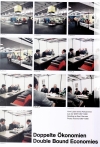Doppelte Ökonomien / Double Bound Economies
Vom Lesen eines Fotoarchivs aus der DDR, 1967 - 1990. On Reading a Photographic Archive
Buchpräsentation mit Doreen Mende, Estelle Blaschke und Armin Linke
Der freischaffende Fotograf Reinhard Mende dokumentierte von 1967 bis 1990 im Auftrag von DDR-Kombinaten Industriebetriebe und die dort hergestellten Produkte, die auf der Internationalen Messe in Leipzig gezeigt wurden. Er nahm Arbeiterinnen an der Werkbank auf, er hielt Lampen, Staubsauger und Küchengeräte fest. Die rund 250.000 Bilder Schwarz-Weiß und Farbfotografien bieten einen einzigartigen Blick in die Werkhallen und auf die Menschen, die die Waren herstellten. Ein Blick, der von offiziellen Vorstellungen geleitet war und trotzdem versuchte, der eigenen Wahrnehmung zu folgen. Das Projekt Doppelte Ökonomien untersucht, wie man mit diesem einzigartigen Corpus an Bildern heute umgehen kann: wie man sie zugänglich macht, wie man historisches Wissen aus ihnen gewinnt, für welche Reflexion sie einen Ausgangspunkt bilden können. Neben einer Anzahl von Essays versammelt das Buch theoretische Texte u.a. von Philip Ursprung, Kerstin Stakemeier, Haile Gabriel Dagne, Mark Fisher, Heinz Hirdina und künstlerische Beiträge u. a. von Katrin Mayer, Tekle Belete, Olaf Nicolai, Christopher Williams und KP Brehmer.
___
Between 1967 and 1990, freelance photographer Reinhard Mende was commissioned by various GDR combines to document factories and the presentation of their manufactured products at the International Trade Fair in Leipzig. He portrayed women at their workbenches, he took shots of lamps, vacuum cleaners and kitchen appliances. The approx. 250,000 pictures in his archive – both in black and white and colour – offer a rare look at the factories and the people who produced all these commodities. Although the perspective was directed by official ideals, Mende followed his own view. The project “Double Bound Economies” explores how we might approach this unique body of images today: how we can access them, how we can derive historical insights from them, and for what considerations they might represent a starting point. Besides a number of essays the book includes texts by Philip Ursprung, Kerstin Stakemeier, Haile Gabriel Dagne, Mark Fisher, Heinz Hirdina and artistic contributions by Katrin Mayer, Tekle Belete, Olaf Nicolai, Christopher Williams and KP Brehmer among others.
